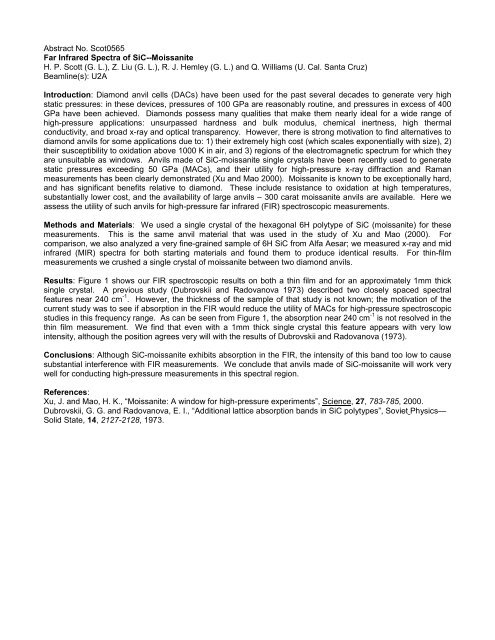Far Infrared Spectra of SiC--Moissanite
Far Infrared Spectra of SiC--Moissanite
Far Infrared Spectra of SiC--Moissanite
You also want an ePaper? Increase the reach of your titles
YUMPU automatically turns print PDFs into web optimized ePapers that Google loves.
Abstract No. Scot0565<br />
<strong>Far</strong> <strong>Infrared</strong> <strong>Spectra</strong> <strong>of</strong> <strong>SiC</strong>--<strong>Moissanite</strong><br />
H. P. Scott (G. L.), Z. Liu (G. L.), R. J. Hemley (G. L.) and Q. Williams (U. Cal. Santa Cruz)<br />
Beamline(s): U2A<br />
Introduction: Diamond anvil cells (DACs) have been used for the past several decades to generate very high<br />
static pressures: in these devices, pressures <strong>of</strong> 100 GPa are reasonably routine, and pressures in excess <strong>of</strong> 400<br />
GPa have been achieved. Diamonds possess many qualities that make them nearly ideal for a wide range <strong>of</strong><br />
high-pressure applications: unsurpassed hardness and bulk modulus, chemical inertness, high thermal<br />
conductivity, and broad x-ray and optical transparency. However, there is strong motivation to find alternatives to<br />
diamond anvils for some applications due to: 1) their extremely high cost (which scales exponentially with size), 2)<br />
their susceptibility to oxidation above 1000 K in air, and 3) regions <strong>of</strong> the electromagnetic spectrum for which they<br />
are unsuitable as windows. Anvils made <strong>of</strong> <strong>SiC</strong>-moissanite single crystals have been recently used to generate<br />
static pressures exceeding 50 GPa (MACs), and their utility for high-pressure x-ray diffraction and Raman<br />
measurements has been clearly demonstrated (Xu and Mao 2000). <strong>Moissanite</strong> is known to be exceptionally hard,<br />
and has significant benefits relative to diamond. These include resistance to oxidation at high temperatures,<br />
substantially lower cost, and the availability <strong>of</strong> large anvils – 300 carat moissanite anvils are available. Here we<br />
assess the utility <strong>of</strong> such anvils for high-pressure far infrared (FIR) spectroscopic measurements.<br />
Methods and Materials: We used a single crystal <strong>of</strong> the hexagonal 6H polytype <strong>of</strong> <strong>SiC</strong> (moissanite) for these<br />
measurements. This is the same anvil material that was used in the study <strong>of</strong> Xu and Mao (2000). For<br />
comparison, we also analyzed a very fine-grained sample <strong>of</strong> 6H <strong>SiC</strong> from Alfa Aesar; we measured x-ray and mid<br />
infrared (MIR) spectra for both starting materials and found them to produce identical results. For thin-film<br />
measurements we crushed a single crystal <strong>of</strong> moissanite between two diamond anvils.<br />
Results: Figure 1 shows our FIR spectroscopic results on both a thin film and for an approximately 1mm thick<br />
single crystal. A previous study (Dubrovskii and Radovanova 1973) described two closely spaced spectral<br />
features near 240 cm -1 . However, the thickness <strong>of</strong> the sample <strong>of</strong> that study is not known; the motivation <strong>of</strong> the<br />
current study was to see if absorption in the FIR would reduce the utility <strong>of</strong> MACs for high-pressure spectroscopic<br />
studies in this frequency range. As can be seen from Figure 1, the absorption near 240 cm -1 is not resolved in the<br />
thin film measurement. We find that even with a 1mm thick single crystal this feature appears with very low<br />
intensity, although the position agrees very will with the results <strong>of</strong> Dubrovskii and Radovanova (1973).<br />
Conclusions: Although <strong>SiC</strong>-moissanite exhibits absorption in the FIR, the intensity <strong>of</strong> this band too low to cause<br />
substantial interference with FIR measurements. We conclude that anvils made <strong>of</strong> <strong>SiC</strong>-moissanite will work very<br />
well for conducting high-pressure measurements in this spectral region.<br />
References:<br />
Xu, J. and Mao, H. K., “<strong>Moissanite</strong>: A window for high-pressure experiments”, Science, 27, 783-785, 2000.<br />
Dubrovskii, G. G. and Radovanova, E. I., “Additional lattice absorption bands in <strong>SiC</strong> polytypes”, Soviet Physics—<br />
Solid State, 14, 2127-2128, 1973.
FIR in <strong>SiC</strong><br />
Transmission<br />
(Dubrovskii et al, 1973)<br />
Intensity<br />
Weak<br />
Feature at<br />
240 cm -1<br />
Absorption:<br />
1.0 mm Thick Crystal<br />
Absorption:<br />
Thin Film<br />
?<br />
100<br />
150<br />
200<br />
Wavenumber (cm -1 )<br />
250<br />
300<br />
Figure 1. FIR spectra <strong>of</strong> <strong>SiC</strong>-moissanite as both a thin film and a<br />
single crystal. For comparison, the transmission spectrum <strong>of</strong> a<br />
previous study (Dubrovskii and Radovanova 1973) is also shown.<br />
The absorption feature at ~240 cm -1 is very low intensity, and we do<br />
not anticipate that it will interfere with high-pressure spectroscopic<br />
measurements conducted in MACs.
















